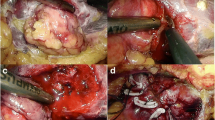Abstract
Objectives
A model for assuring clamping success was established for laparoscopic partial nephrectomy (LPN) with segmental renal artery clamping (SRAC).
Materials and methods
Patients (n = 107; December 2009–September 2011) who underwent LPN with SRAC dependent on the experience of the surgeon and CTA were retrospectively reviewed to determine the optimal characteristics of target arteries. After multiple logistic regression analysis, variables used to build a nomogram were selected using a backward elimination scheme. A model for a clamping program customized to the patient was designed. The surgical outcomes of patients (n = 141; October 2011–June 2014) who subsequently underwent LPN-SRAC with the applied model were compared with those of the first group of patients.
Results
Five potential predictors were initially assessed: segmental renal artery angle, target artery diameter, and distance (d) to the abdominal aorta, renal hilum (d RH), and kidney midline (d KML). The regression equation was set up as:
Comparing the patient groups, those for whom the new SRAC model was applied had a significantly better success rate of clamping (P < 0.001), less total operative time (P < 0.001), and less operative blood loss (P = 0.042). No obvious differences were observed in time of warm ischemia, postoperative hospitalization, RENAL nephrometry score, or number of final clamped branches.
Conclusions
The model for assuring clamping success was helpful in designing an SRAC program and thus benefiting the LPN procedure.



Similar content being viewed by others
References
Winfield HN, Donovan JF, Godet AS et al (1993) Laparoscopic partial nephrectomy: initial case report for benign disease. J Endourol 7:521–526
Heuer R, Gill IS, Guazzoni G et al (2010) A critical analysis of the actual role of minimally invasive surgery and active surveillance for kidney cancer. Eur Urol 57:223–232
Gill IS, Desai MM, Kaouk JH et al (2002) Laparoscopic partial nephrectomy for renal tumor: duplicating open surgical techniques. J Urol 167:469–476
Kim SP, Thompson RH, Boorjian SA et al (2012) Comparative effectiveness for survival and renal function of partial and radical nephrectomy for localized renal tumors: a systematic review and meta-analysis. J Urol 188:51–57
Gill IS, Patil MB, Abreu AL et al (2012) Zero ischemia anatomical partial nephrectomy: a novel approach. J Urol 187:807–814
Shichiri Y, Takao N, Oida T et al (2004) Laparoscopic partial nephrectomy for a renal tumor with tumor-feeding artery ligation: left renal cell carcinoma in the posterior mid zone. Int J Urol 11:1019–1023
Shao P, Qin C, Yin C et al (2011) Laparoscopic partial nephrectomy with segmental renal artery clamping: technique and clinical outcomes. Eur Urol 59:849–855
Xu Y, Shao P, Zhu X et al (2013) Three-dimensional renal CT angiography for guiding segmental renal artery clamping during laparoscopic partial nephrectomy. Clin Radiol 68:e609–e616
Shao P, Tang L, Li P et al (2012) Precise segmental renal artery clamping under the guidance of dual-source computed tomography angiography during laparoscopic partial nephrectomy. Eur Urol 62:1001–1008
Shao P, Tang L, Li P et al (2013) Application of a vasculature model and standardization of the renal hilar approach in laparoscopic partial nephrectomy for precise segmental artery clamping. Eur Urol 63:1072–1081
Shao P, Li P, Xu Y et al (2014) Application of combined computed tomography arteriography, venography, and urography in laparoscopic partial nephrectomy with segmental artery clamping. Urology 84:1361–1365
Weld KJ, Bhayani SB, Belani J et al (2005) Extrarenal vascular anatomy of kidney: assessment of variations and their relevance to partial nephrectomy. Urology 66:985–989
Porpiglia F, Fiori C, Bertolo R et al (2012) Long-term functional evaluation of the treated kidney in a prospective series of patients who underwent laparoscopic partial nephrectomy for small renal tumors. Eur Urol 62:130–135
Thompson RH, Lane BR, Lohse CM et al (2012) Renal function after partial nephrectomy: effect of warm ischemia relative to quantity and quality of preserved kidney. Urology 79:356–360
Finley DS, Lee DI, Eichel L et al (2005) Fibrin glue surgical sandwich for laparoscopic wedge resection of small renal lesions. J Urol 173:1477–1481
Kutikov A, Uzzo RG (2009) The R.E.N.A.L. nephrometry score: a comprehensive standardized system for quantitating renal tumor size, location and depth. J Urol 182:844–853
Funding
This work was supported by the Priority Academic Program Development of Jiangsu Higher Education Institutions (PAPD), and the Jiangsu Provincial Special Program of Medical Science (BL2012027).
Author information
Authors and Affiliations
Corresponding authors
Ethics declarations
Conflict of interest
The authors declare that they have no conflict of interest.
Ethical standard
Approval received from Local Ethics Committee.
Additional information
Xiao Li, Yuan Huang, and Wangyan Liu have contributed equally to this work.
Rights and permissions
About this article
Cite this article
Li, X., Huang, Y., Liu, W. et al. A model for assuring clamping success during laparoscopic partial nephrectomy with segmental renal artery clamping. World J Urol 34, 1421–1427 (2016). https://doi.org/10.1007/s00345-016-1785-7
Received:
Accepted:
Published:
Issue Date:
DOI: https://doi.org/10.1007/s00345-016-1785-7




